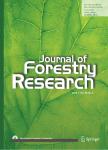Structure, composition and diversity of tree species in tropical moist deciduous forests of Eastern India: a case study of Nayagarh Forest Division, Odisha
Structure, composition and diversity of tree species in tropical moist deciduous forests of Eastern India: a case study of Nayagarh Forest Division, Odisha作者机构:Taxonomy and Conservation Division Regional Plant Resource Centre Nayapalli Bhubaneswar Odisha 751015India Centre of Biotechnology Sikshya O Anusandhan UniversityGhatikia Bhubaneswar Odisha 751003 India
出 版 物:《Journal of Forestry Research》 (林业研究(英文版))
年 卷 期:2017年第28卷第6期
页 面:1212-1223页
核心收录:
学科分类:09[农学] 0903[农学-农业资源与环境]
基 金:funded by the Department of Forest and Environment Government of Odisha Bhubaneswar
主 题:Eastern India Nayagarh Forest Division Odisha Tree diversity
摘 要:Quantitative assessment of tree species diversity from sample plots in seven forest ranges of Nayagarh Forest Division in Odisha state in the Eastern Ghats of India was made during the period April, 2011 to November, 2013. A total of 120 transects(1000 m × 5 m) were laid in Nayagarh, Odogaon, Pancharida, Khandapada, Dasapalla,Mahipur, and Gania forest ranges and tree stems of at least 30 cm GBH were measured. The regeneration potential of trees was assessed from 5 m × 5 m sample plots located within the main transect. A total of 177 tree species belonging to 120 genera and 44 families were recorded from the study area. Shorea robusta, Buchanania lanzan, Lannea coromandelica, Terminalia alata and Cleistanthus collinus were the predominant tree species. The stand density varied in the range of 355.33–740.53 stems ha)-1) while basal area ranged from 7.77 to 31.62 m2ha-1. The tree density and species richness decreased with increasing girth class. The highest number of species and maximum density was recorded in the girth class of 30–60 cm. The Shannon–Weiner and Simpson Indices with respect to trees with C30 cm GBH varied in the range of 2.07–3.79 cm and 0.03–0.37 cm respectively and the values of diversity indices are within the reported range for tropical forests of Indian sub-continent. The families, Dipterocarpaceae,Anacardiaceae, Combretaceae and Euphorbiaceae contributed to maximum species richness, stand density, and basal area. Regeneration of many tree species was observed to be poor. The present study provides baseline data for further ecological studies, forest management, and formulation of site-specific strategies for conservation of biological diversity in moist deciduous forests of Eastern India.



